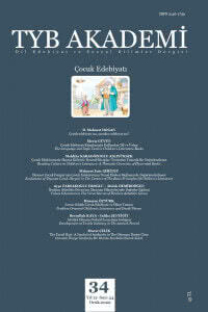Dostoyevski ve Safa’nın Estetisizmi: Suç ve Ceza ile Matmazel Noraliya’nın Koltuğu
Dostoevsky’s and Safa’s Aestheticism: Crime And Punishment and Matmazel Noraliya’nın Koltuğu
___
- Bakhtin, Mikhail. Rabelais and His World. Trans. by Helene Iswolsky. Indiana University Press, 1984.
- Bürger, Peter. Theory of the Avant-Garde. Minneapolis: University of Minnesota Press, 1984.
- Comfort, Kelly. “Introduction: Reflections on the Relationship between Art and Life in Aestheticism”. Art and Life in Aestheticism De-Humanizing and Re-Humanizing Art, the Artist, and the Artistic Receptor. Ed. Kelly Comfort. Houndmills: Palgrave Macmillan, 2008. 1-21.
- Conradi, Peter. Fyodor Dostoevsky, Macmillan, 1988.
- Cooper, David E. “Introduction”. Aesthetics: The Classic Readings. Ed. David E. Cooper. Blackwell Publishers, 1997. 1-10.
- Dentith, Simon. Bakhtinian Thought. London: Routledge, 1995.
- Dostoevsky, Fyodor. Crime and Punishment, London: Penguin, 1997.
- Fanger, Donald. Dostoevsky and Romantic Realism, Evanston: Northwestern University Press, 1998.
- Gardner, Sebastian. “Philosophical Aestheticism.” The Oxford Handbook of Continental Philosophy. Oxford University Press, 2007.
- http://www.oxfordhandbooks.com/view/10.1093/oxfordhb/9780199234097.001.0001/ oxfordhb-9780199234097-e-4.
- Guyer, Paul. “The Origins of Modern Aesthetics: 1711 – 35”. The Blackwell Guide to Aesthetics. Ed. Peter Kivy. Blackwell Publishing, 2004. 15-44.
- Kant, Immanuel. “Critique of Aesthetic Judgement”. Aesthetics: The Classic Readings. Ed. David E. Cooper. Blackwell Publishers, 1997. 94-122.
- Kantarcıoğlu, Sevim. Türk ve Dünya Romanlarında Modernizm, İstanbul: Paradigma, 2007.
- Kayser, Wolfgang. The Grotesque in Art and Literature. New York: Columbia University Press, 1981.
- Mochulsky, Konstantin. “Crime and Punishment: A Novel Tragedy in Five Acts.” Critical Essays on Dostoevsky. Ed. Robin Feuer Miller. Boston: G.K.Hall & Co., 1986. 90-100.
- Safa, Peyami. Matmazel Noraliya’nın Koltuğu, İstanbul: Ötüken, 2004.
- Tekin, Mehmet. Peyami Safa’nın Roman Sanatı ve Romanları Üzerinde bir Araştırma, Konya: Selçuk Üniversitesi Yayınları, 1990.
- Yetkin, Çetin. Türk Edebiyatında Batılılaşma ve Kimlik Sorunu, İstanbul: Salyangoz Yayınları, 2008.
- ISSN: 2146-1759
- Yayın Aralığı: 3
- Başlangıç: 2011
- Yayıncı: Mustafa Ekici
Dede Korkut Hikâyelerinin Ucubesi: Tepegöz
İstanbul’un Kaybolan Değerlerinden İncili Köşk (Sinan Paşa Köşkü)
Mehmet Şemseddin Ulusoy’un Güftâr-ı Şemsî Adlı Dîvan’ı
Evrâk-ı Eyyâm’da Mizahî ve İronik Yaklaşımlar
Aziz Nesin’in Toros Canavarı Oyununda Yapı, Mizah ve İroni
“Fark Yaratma” Salgınının Taşıyıcısı Olarak Komedi Ya Da Az Ağlamak Çok Gülmek
Dostoyevski ve Safa’nın Estetisizmi: Suç ve Ceza ile Matmazel Noraliya’nın Koltuğu
